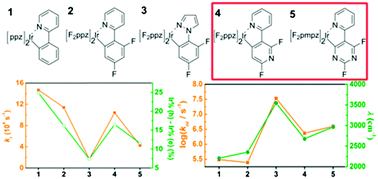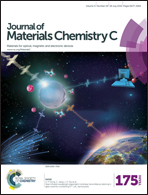Understanding the efficiency drooping of the deep blue organometallic phosphors: a computational study of radiative and non-radiative decay rates for triplets†
Abstract
High-efficiency deep blue organometallic phosphors are imperative to organic luminescence devices. While green iridium complexes commonly exhibit high luminescence efficiencies, the luminescence quantum efficiency always drops sharply when emission becomes deep blue. In this work, the microscopic mechanism of such a drastic decrease is elucidated from detailed computational investigation. Both radiative (kr) and non-radiative (knr) decay rates of the lowest triplet state (T1) are calculated for five representative cyclometalated iridium(III) complexes with emission color ranging from green to deep blue, based on phenylpyridyl, phenylpyrazolyl, bipyridinato, pyrimidinpyridyl, and pyrimidinprazolyl ligands. For all compounds, the T1 states are characteristic of mixed intraligand (π → π*) transition and iridium-to-ligand charge transfer (d → π*), and the increased π → π* and decreased d → π* portions lead to the blue-shifted emission of 1 < 2 < 4 < 5 < 3. Strikingly, it is found that the drastic increase of knr arising from severe intra-ligand vibration relaxations induced by the enhanced π → π* transition is mainly responsible for the droop of the phosphorescence quantum efficiency, which provides a different deactivation mechanism from the thermally-activated transformation into a dark metal-centred ligand field excited state reported in many previous studies. Compared with the well-studied compounds 1–3, the newly designed compounds 4 and 5 achieve a good balance between high efficiency and a large energy gap and are very promising as deep blue phosphors. These findings are expected to be helpful for the rational design of high-efficiency blue organometallic phosphors, especially in terms of ligands.


 Please wait while we load your content...
Please wait while we load your content...